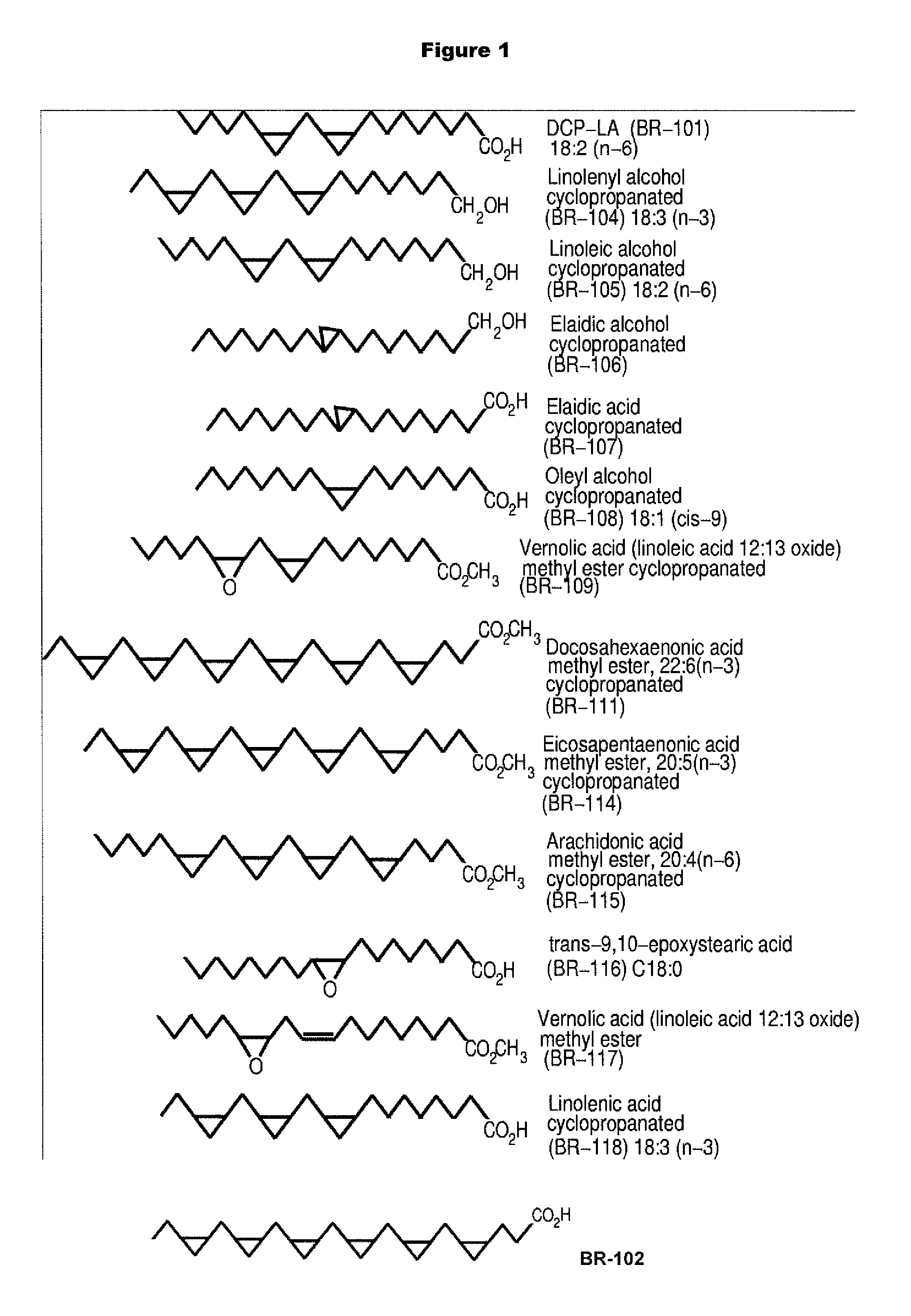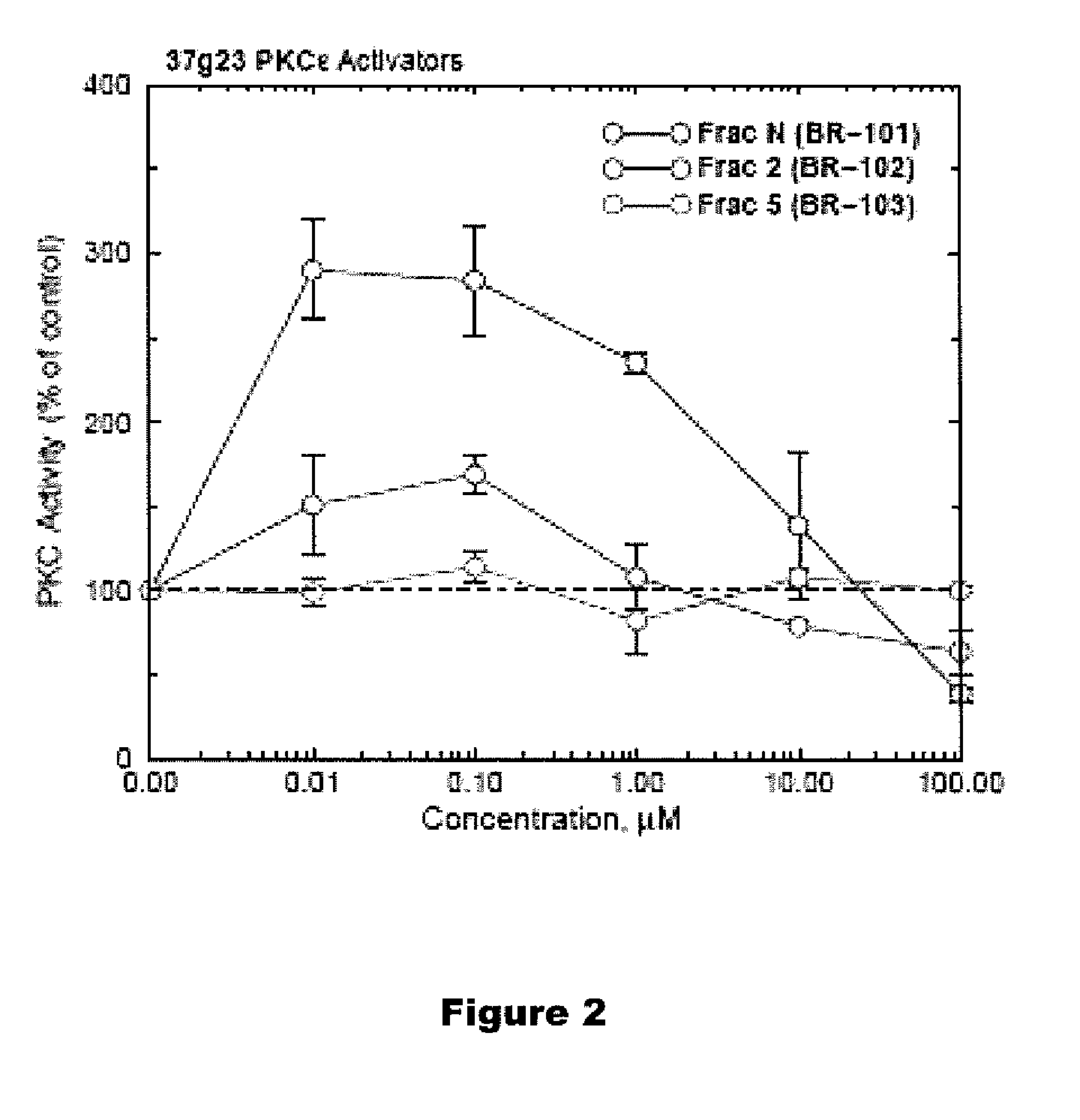PKC-Activating Compounds for the Treatment of Neurodegenerative Diseases
a neurodegenerative disease and activating compound technology, applied in the direction of biocide, drug composition, transferase, etc., can solve the problems of limited therapeutic options, neuronal damage and cell death, and mental deterioration and ultimately death
- Summary
- Abstract
- Description
- Claims
- Application Information
AI Technical Summary
Problems solved by technology
Method used
Image
Examples
example 1
Synthesis of Fatty Acid Methyl Esters Cyclopropanated Fatty Acid Methyl Esters
[0106]Synthesis of cyclopropanated fatty acids. Methyl esters of polyunsaturated fatty acids were cyclopropanated using the modified Simmons-Smith reaction using chloroiodomethane and diethylzinc (Tanaka et al., Bioorg. Med. Chem. Let. 2003; 13: 1037-40; Furukawa et al., Tetrahedron. 1967; 53-58; Denmark et al., J. Org. Chem. 1991; 56: 6974-81). All apparatus was baked at 60° C. for 1 hr and dried using a flame with dry nitrogen. A 100 ml 3-neck round bottom flask with a stirring bar and a temperature probe was surrounded by an ice-dry ice mixture and filled with 1.25 g (4.24 mmol) linoleic acid methyl ester or docosahexaenoic acid methyl ester in 25 ml dichloromethane and bubbled with N2. A 1M solution of diethylzinc (51 ml, 54.94 mmol) in hexane was added anaerobically using a 24-inch-long 20-gauge needle and the solution was cooled to −5° C. Diiodomethane (8.2 ml, 101.88 mmol) or chloroiodomethane (ClCH...
example 2
Activation of Purified PKC Epsilon using Docosahaexanoic Acid
[0112]Protein kinase C assay, Recombinant PKC (1 ng of alpha or epsilon isoform) was mixed with the BR-101 (DCP-LA) in the presence of 10 micromolar histones, 5 mM CaCl2, 1.2 μg / μl phosphatidyl-L-serine, 0.18 μg / μl 1,2-dioctanoyl-sn-glycerol (DAG), 10 mM MgCl2, 20 mM HEPES (pH 7.4), 0.8 mM EDTA, 4 mM EGTA, 4% glycerol, 8 μg / ml aprotinin, 8 μg / ml leupeptin, and 2 mM benzamidine. 0.5 micro Ci [γ32P]ATP was added. The incubation mixture was incubated for 15 min at 37 degrees in a total volume of 10 microliters. The reaction was stopped by spotting the reaction mixtures on 1×2 cm strips of cellulose phosphate paper (Whatman P81) and immediately washing twice for 1 hr in 0.5% H3PO4. The cellulose phosphate strips were counted in a scintillation counter. In some experiments, phosphatidylserine, diacylglycerol, and / or calcium were removed.
[0113]DHA methyl ester was purchased from Cayman Chemical (Ann Arbor, Mich.). PKC isozymes w...
example 3
Activation of Purified or Cellular PKC Epsilon using Other PKC Activators
[0115]Materials. Culture media were obtained from K-D Medical (Columbia, Md.) or Invitrogen (Carlsbad, Calif.). Aβ1-42 was purchased from Anaspec (San Jose, Calif.). Polyunsaturated fatty acid methyl esters were obtained from Cayman Chemicals, Ann Arbor, Mich. Other chemicals were obtained from Sigma-Aldrich Chemical Co. (St. Louis, Mo.). PKC isozymes were from Calbiochem (San Diego, Calif.). Purified PKCε was purchased from Calbiochem.
[0116]Cell culture. Rat hippocampal H19-7 / IGF-IR cells (ATCC, Manassas, Va.) were plated onto poly-L-lysine coated plates and grown at 35° C. in DMEM / 10% FCS for several days until about 50% coverage was obtained. The cells were then induced to differentiate into a neuronal phenotype by replacing the medium with 5 ml N2 medium containing 10 ng / ml basic fibroblast growth factor at 39° C. and grown in T-75 flasks at 37° C. Human SH-SY5Y neuroblastoma cells (ATCC) were cultured in 4...
PUM
| Property | Measurement | Unit |
|---|---|---|
| structure | aaaaa | aaaaa |
| concentration | aaaaa | aaaaa |
| fatty acid | aaaaa | aaaaa |
Abstract
Description
Claims
Application Information
 Login to View More
Login to View More - R&D
- Intellectual Property
- Life Sciences
- Materials
- Tech Scout
- Unparalleled Data Quality
- Higher Quality Content
- 60% Fewer Hallucinations
Browse by: Latest US Patents, China's latest patents, Technical Efficacy Thesaurus, Application Domain, Technology Topic, Popular Technical Reports.
© 2025 PatSnap. All rights reserved.Legal|Privacy policy|Modern Slavery Act Transparency Statement|Sitemap|About US| Contact US: help@patsnap.com



